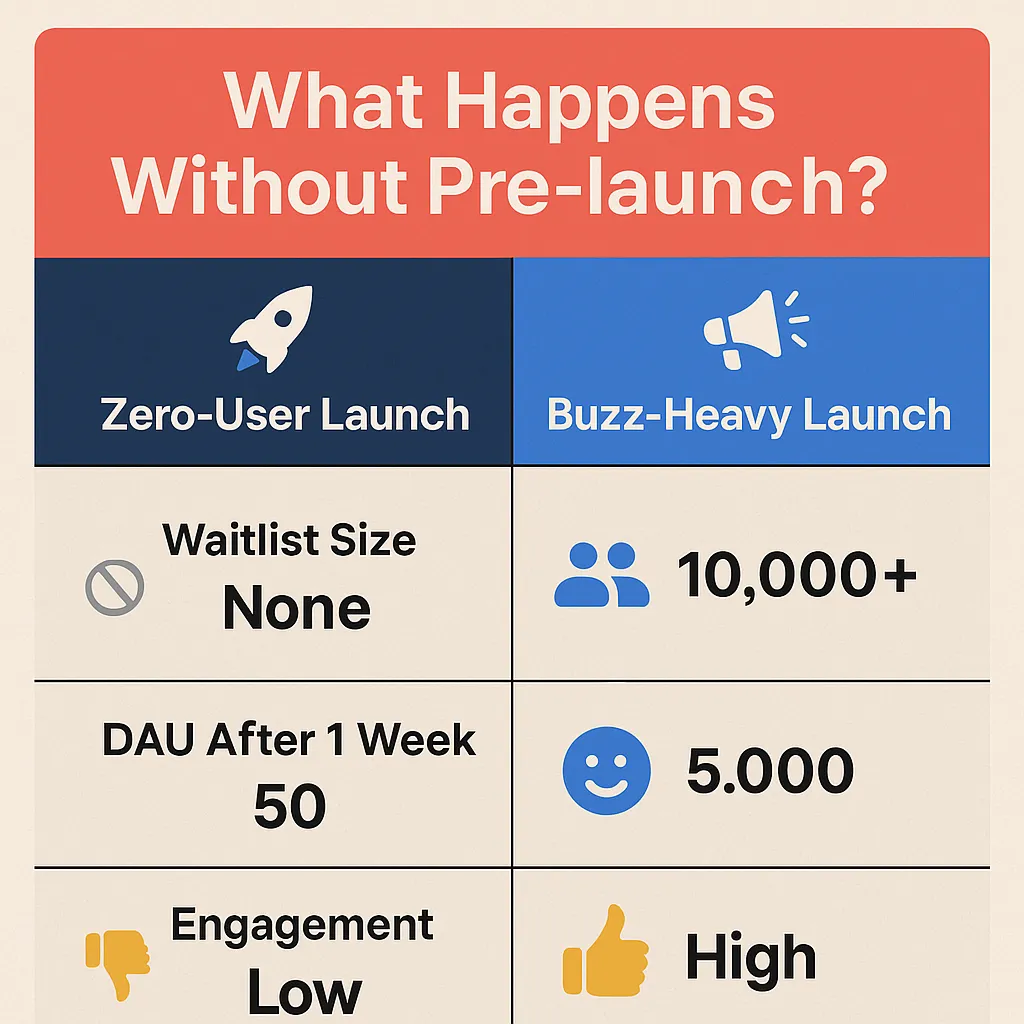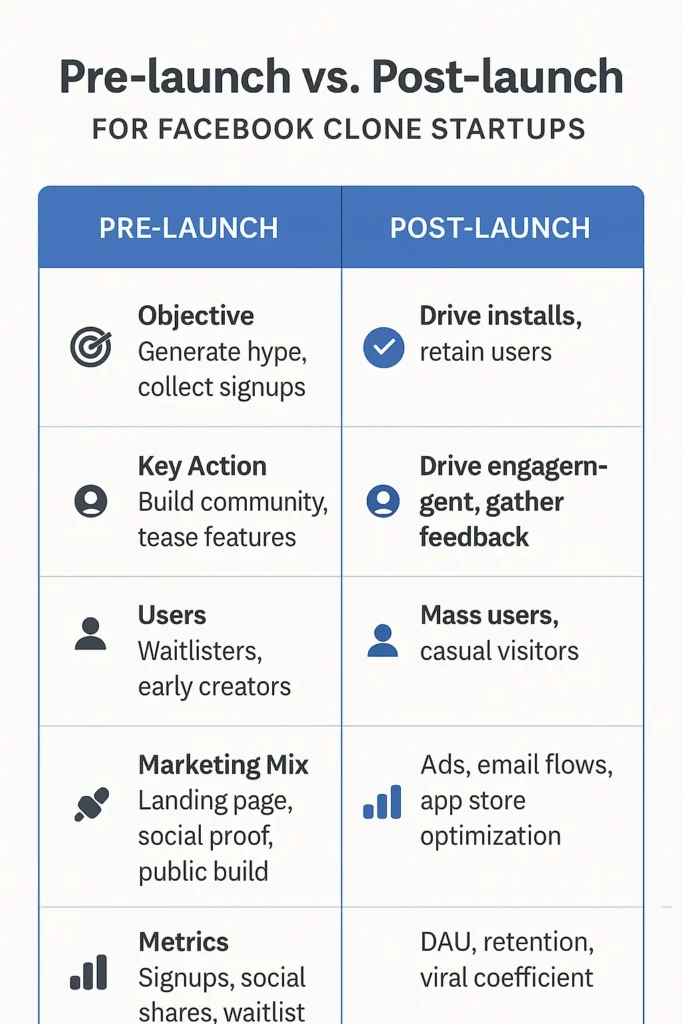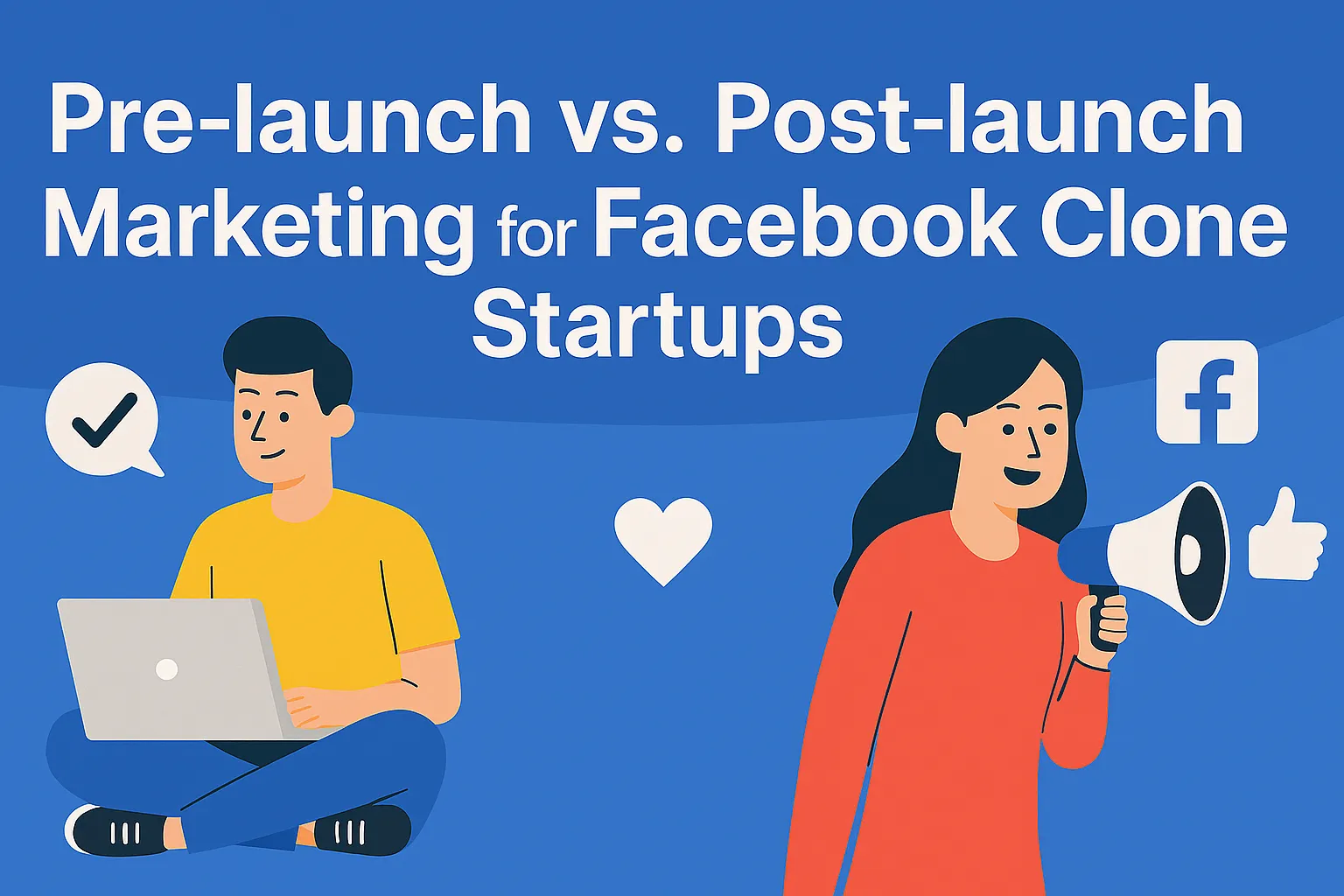You’ve got the blueprint, the backend’s humming, and your social feed looks slicker than a cat on a marble floor. But here’s the million-like question: how do you make sure your Facebook clone doesn’t just exist—but actually thrives?
The truth? Building a Facebook alternative is only half the battle. The other half is making sure people show up Statista, stick around, and actually talk to each other. We’ve seen countless startups pour heart and hustle into development, only to forget that marketing starts before the “Launch” button is even pressed.
This blog is your no-fluff, real-talk guide to winning both before and after go-live. We’ll cover what separates pre-launch dreamers from post-launch dominators—and how Miracuves helps visionary founders get both phases right.

Why Pre-launch Marketing is the Underrated MVP
You Don’t Launch a Social Network Into Silence
Launching a Facebook clone without pre-launch buzz is like opening a party with no invites sent. Crickets. Today’s users are spoiled for choice—with apps like Instagram, Reddit, Mastodon, and even Threads fighting for their attention spans.
Pre-launch marketing gets people curious. It’s how you build FOMO before the app’s even available. From email waitlists to Discord sneak peeks, this phase isn’t optional—it’s your user acquisition runway.
Pre-launch Strategies That Set You Up for a Viral Start
1. Launch a Hype-driven Landing Page
Your pre-launch landing page should do one thing: collect emails. Keep it lean but convincing. Drop in a teaser video, a few juicy bullet points (e.g., “Ad-free,” “Custom feeds,” “Built-in wallet”), and a CTA like “Reserve Your Username”.
Use tools like Unbounce, Webflow, or Framer to go live in hours, not days.
2. Get Your Founding Creators In Early
Just like Facebook began with Harvard students, your social network needs a seeded community. Handpick 50–100 creators—writers, niche influencers, meme lords—and give them beta access. Their early content will prevent a ghost town on launch day.
Also, create a private group chat for them. Make them feel like insiders, not just testers.
3. Share the Build (and the Bugs) in Public
Use Twitter, LinkedIn, even TikTok to share sneak peeks and behind-the-scenes builds. Authenticity builds trust. Don’t be afraid to show failed UI experiments or internal Slack jokes.
“Marketing is just storytelling. So, tell yours before the product is even done.”
4. Build a Micro-community Before the Macro One
Use Telegram, Discord, or Slack to gather early sign-ups. This builds hype and lets you validate your core features in real time. Bonus: it gives you your first few power users and moderators.
Post-launch Marketing: Time to Hit the Pedal
1. Blast Your Launch Loud and Wide
Go full-scope: Product Hunt, IndieHackers, Reddit’s r/startups, and every last person on your email list. Ask your early creators to post live walkthroughs. Turn your first 100 users into 1,000 via smart referral programs.
2. Focus on Retention, Not Just Installs
Getting installs is great. Keeping users is better. Use email re-engagement flows, push notifications with social triggers (“You’ve got 5 new follows!”), and gamify user milestones.
Remember: Facebook didn’t take off because people installed it. It grew because they stayed.
3. Run Targeted Ads With Creator Testimonials
Instead of cold ads, use authentic short-form creator videos. Think: “Here’s why I stopped using Facebook and switched to X.” Run these as YouTube pre-rolls or TikTok promos with proper UGC hooks.
4. Introduce New Features in Public
Roll out new stuff (like profile badges or groups) with transparency. Create polls: “Should we build Stories next or improve Groups?” Involve users in the journey so they feel like co-founders.
Pre-launch vs Post-launch: The Key Differences
| Phase | Pre-launch | Post-launch |
|---|---|---|
| Objective | Generate hype, collect signups | Drive installs, retain users |
| Key Action | Build community, tease features | Drive engagement, gather feedback |
| Users | Waitlisters, early creators | Mass users, casual visitors |
| Marketing Mix | Landing page, social proof, public build | Ads, email flows, app store optimization |
| Metrics | Signups, social shares, waitlist growth | DAU, retention, viral coefficient |
Why Facebook Clone Startups Must Nail Both Halves
You can’t skip pre-launch and expect miracles. And you can’t coast after launch and expect growth. A Facebook-like app—loaded with friend lists, feeds, chats, and groups—needs constant momentum. Think network effect, not one-time downloads.
Learn More: Why Startup Choose Facebook Clone Over Custom Development
Startups that nail both halves? They create magnetic apps with loyal users who don’t just use the product—they build their digital lives around it.
Build Your Own Facebook Clone App with Miracuves

Conclusion
Launching a social app without marketing is like showing up to a party without music. If you’re not creating buzz before and after launch, you’re leaving success up to chance.
At Miracuves, we help innovators launch high-performance app clones that are fast, scalable, and monetization-ready. Ready to turn your idea into reality? Let’s build together.
FAQs
1) How early should I start pre-launch marketing?
Start immediately — with Miracuves delivering your solution in just 3–6 days with guaranteed delivery, you can begin gathering feedback, building anticipation, and refining your pitch right from day one.
2) What’s the biggest mistake founders make post-launch?
Focusing only on installs instead of user retention. A sticky product matters more than flashy installs.
3) Do I need a referral program?
Highly recommended. Word-of-mouth still trumps ads when it comes to social apps.
4) How do I attract my first 1000 users?
Seed content creators, incentivize shares, use waitlists and launch giveaways.
5) What role does community play in marketing?
A huge one. Communities create organic content, drive retention, and boost virality.
6) How does Miracuves support marketing?
We guide you through go-to-market strategies and help build monetization-friendly, scalable apps tailored to your audience.








